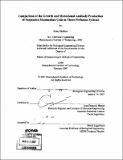Comparison of the growth and monoclonal antibody production of suspended mammalian cells in three perfusion systems
Author(s)
Hufford, Kathy (Kathy E.)
DownloadFull printable version (8.846Mb)
Other Contributors
Massachusetts Institute of Technology. Biological Engineering Division.
Advisor
Jean-Francois Hamel.
Terms of use
Metadata
Show full item recordAbstract
The purpose of this thesis was to provide a broad survey of bioprocess options for typical drug production vehicles in the biotechnology industry. This goal was accomplished by comparing the growth and monoclonal antibody production by HPCHO Chinese hamster ovary cells and IB4 hybridoma cells in batch, fed-batch, and three perfusion systems: the stirred ceramic membrane reactor (SCMR), the alternating tangential flow (ATF) hollow fiber membrane system, and the external spin filter (ESF) system. The batch experiments for each cell line were used as base case scenarios for the comparisons of cell growth and monoclonal antibody production. The fed-batch experiments for each cell line did not vastly improve the cell growth and monoclonal antibody production over the batch cases. The SCMR perfusion system greatly improved the cell growth and monoclonal antibody production for each cell line. The maximum viable cell concentration of the IB4 hybridoma cells in the SCMR experiment was over seven times that found in the batch experiment and the monoclonal antibody production in the SCMR experiment was over ten times that found in the batch experiment. (cont.) The ATF perfusion system greatly increased the cell growth for each cell line over the batch cases, but the shear forces created by the system adversely affected the viability of the cells and the monoclonal antibody production was less than that of the SCMR experiments. The ESF perfusion system damaged the HPCHO Chinese hamster ovary cells. For the production of the IB4 hybridoma cells, the ESF system, as well as a modified ESF system, did not vastly improve the cell growth and monoclonal antibody over the base case due to cell aggregation and filter fouling. The cell growth and productivity data, along with economic considerations, were evaluated for the purpose of recommending the best feeding strategy for each of the two cell lines studied. It was concluded that the most successful operation mode for the two cell lines studied was the SCMR perfusion system. More research is needed regarding the scale-up ramifications of the SCMR perfusion system as well as in the quantification of monoclonal antibodies, the optimization of fed-batch systems, and the use of alternative perfusion systems.
Description
Thesis (M. Eng.)--Massachusetts Institute of Technology, Biological Engineering Division, 2007. Includes bibliographical references (leaves 139-141).
Date issued
2007Department
Massachusetts Institute of Technology. Department of Biological EngineeringPublisher
Massachusetts Institute of Technology
Keywords
Biological Engineering Division.